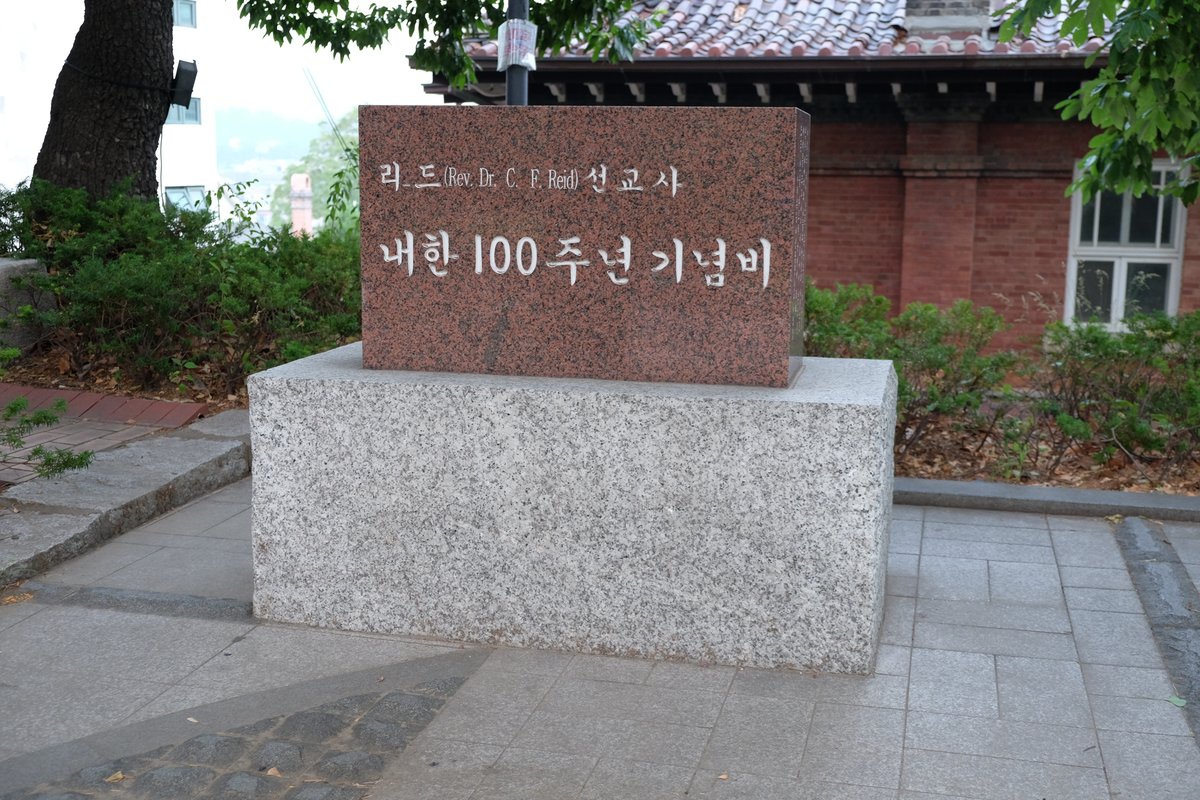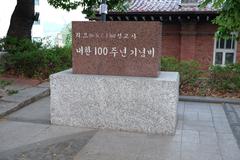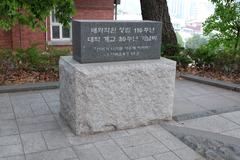
Paiwha Girls’ High School Seoul: Visiting Hours, Tickets, and Historical Significance
Date: 14/06/2025
Introduction
Nestled in the heart of Seoul’s Jongno District, Paiwha Girls’ High School (배화여자고등학교) is more than just an educational institution—it is a living testament to Korea’s commitment to women’s education and cultural transformation. Founded in 1898 by American missionary Alice Rebecca Appenzeller, the first American born in Korea, Paiwha became a beacon for the advancement of Korean women during an era of rapid modernization and Western influence (LA Times). Its campus, including the historic hanok dormitory, stands as a blend of traditional Korean and Western architecture, offering visitors a unique glimpse into the country’s educational and architectural heritage (Journal of Architectural History).
This guide provides comprehensive details on Paiwha Girls’ High School’s visiting hours, ticket arrangements, historical background, and practical tips, ensuring you have an enriching and respectful experience at one of Seoul’s most significant historical landmarks.
Table of Contents
- Introduction
- Historical Background
- Architectural Highlights
- Visiting Information: Hours, Tickets, and Access
- Visitor Etiquette and Accessibility
- Special Experiences and Events
- Nearby Attractions and Recommended Itinerary
- Frequently Asked Questions
- Conclusion and Visitor Recommendations
- References and Further Reading
Historical Background
Founding and Early Influence
Paiwha Girls’ High School, initially known as Paiwha Hakdang, was established in 1898 by Alice Rebecca Appenzeller. At a time when educational opportunities for Korean women were scarce, the school pioneered a curriculum combining traditional values with Western subjects such as English, mathematics, science, and music (LA Times). Its mission was to empower Korean girls and foster a new generation of educated women.
Growth Through Adversity
During the Japanese colonial era (1910–1945), Paiwha Girls’ High School faced significant challenges, including restrictions on Korean language and cultural expression. Nevertheless, it remained a sanctuary for Korean identity and the empowerment of women, nurturing leaders who would later play key roles in the nation’s development.
After Korea’s liberation, Paiwha adapted to the modern education system and was officially recognized as a high school in 1953 (Wikipedia: High schools in Seoul). Its alumni have contributed to diverse fields, embodying the school’s motto: “Be true, kind and beautiful.”
Architectural Highlights
Hanok Dormitory and Blended Architecture
A standout feature of Paiwha’s campus is the historic hanok dormitory—a rare, early 20th-century building that fuses traditional Korean wooden architecture with Western elements. The dormitory, once home to students from beyond Seoul, has been carefully restored, preserving its original structure while modernizing facilities (Journal of Architectural History). The campus also features a classic red-brick main hall and a symbolic bell tower, both integral to the school’s identity (Korean Heritage Service).
Cultural Heritage Status
Paiwha’s historic dormitory is a Registered Cultural Heritage site (No. 93), reflecting its significance in Korea’s educational and architectural history. The campus is also known for its landscaped courtyards, gingko-lined walkways, and small museum, which displays artifacts chronicling the evolution of women’s education in Korea (Seoul Cultural Heritage).
Visiting Information: Hours, Tickets, and Access
Visiting Hours
- Regular Hours: Monday–Friday, 9:00 AM–5:00 PM (school grounds and hanok dormitory)
- Weekends: Visits by special appointment only
- Special Events: Public access during heritage open days and the annual Paiwha Festival (usually in autumn)
- Restrictions: Closed during examination periods and school holidays to maintain a respectful and undisturbed learning environment
Tickets and Admission
- General Admission: Free
- Guided Tours: Available in Korean and English by advance reservation; booking required for in-depth campus and dormitory tours
- Group Visits: Must be arranged with the school administration in advance
Location and Directions
- Address: 7, Sajik-ro 9-gil, Jongno-gu, Seoul, South Korea
- Subway: Line 3, Gyeongbokgung Station, Exit 2 (10 minutes on foot)
- Bus: City buses 171, 272, 601 (Seoul Metro Map)
Visitor Etiquette and Accessibility
Etiquette Guidelines
- Maintain a respectful, quiet demeanor—school activities are ongoing during visits
- Photography is limited to designated areas; explicit permission is required to photograph students or classrooms
- Modest attire is recommended, consistent with the school’s values
- Smoking and littering are strictly prohibited
Accessibility
- Modern buildings are wheelchair accessible; however, the historic hanok dormitory has limited accessibility due to its traditional design
- Some English signage is provided; English-speaking guides are available by arrangement
- International visitors can access virtual tours and images via the school’s official website
Special Experiences and Events
- Paiwha Festival: Annual event in autumn featuring student performances, traditional games, and exhibitions
- School Museum: Exhibits artifacts and documents chronicling women’s education in Korea
- Photographic Spots: The bell tower, red-brick main hall, and landscaped courtyards offer picturesque settings
Nearby Attractions and Recommended Itinerary
Enhance your visit by exploring nearby cultural sites:
- Gyeongbokgung Palace: Korea’s largest royal palace, just a short walk away
- Seochon Village: Traditional hanok homes, artisan shops, and local cafes
- Cheongwadae (Blue House): Former presidential residence
- National Folk Museum of Korea: Exhibits on Korean culture and history
Suggested Itinerary:
Morning at Paiwha Girls’ High School → Lunch in Seochon Village → Afternoon at Gyeongbokgung Palace
Frequently Asked Questions (FAQ)
Q: Is Paiwha Girls’ High School open to the public year-round?
A: No, public access is limited to special events and by appointment, as Paiwha is an active school.
Q: Are tickets required for visiting?
A: Admission is free, but guided tours and group visits require advance arrangements.
Q: Are English-language tours available?
A: Yes, by prior arrangement or during special events.
Q: Are the facilities wheelchair accessible?
A: Most modern areas are accessible; historic structures like the hanok dormitory have limited accessibility.
Q: Can I take photographs on campus?
A: Yes, in designated areas only. Permission is required to photograph students or classrooms.
Conclusion and Visitor Recommendations
Paiwha Girls’ High School stands as a vivid symbol of Korea’s educational reform, cultural resilience, and the enduring legacy of women’s empowerment. Its campus, marked by historic architecture and vibrant traditions, offers a rare opportunity for visitors to connect with Korea’s past and present. By respecting the school’s guidelines and planning your visit in conjunction with nearby attractions, you can enjoy a comprehensive and respectful cultural experience.
For up-to-date information on visiting hours, guided tours, and event schedules, consult the official Paiwha Girls’ High School website and the Seoul tourism portal.
Enhance your experience further by exploring virtual tours, downloading travel apps, and connecting with Seoul’s broader historical and cultural network.
References and Further Reading
- LA Times
- Korean Heritage Service - Paiwha Girls’ High School Dormitory
- Paiwha Girls’ High School Official Website
- Seoul Tourism Official Site
- Journal of Architectural History
- Seoul Cultural Heritage
- Seoul Metro Map
- Gyeongbokgung Palace
- Mapcarta - Location Map
- Hanok Heritage Preservation Division
- Namu Wiki - Paiwha Girls’ High School
All images and virtual resources are available on the official Paiwha Girls’ High School website, with descriptive alt tags for accessibility.














































































































































































































